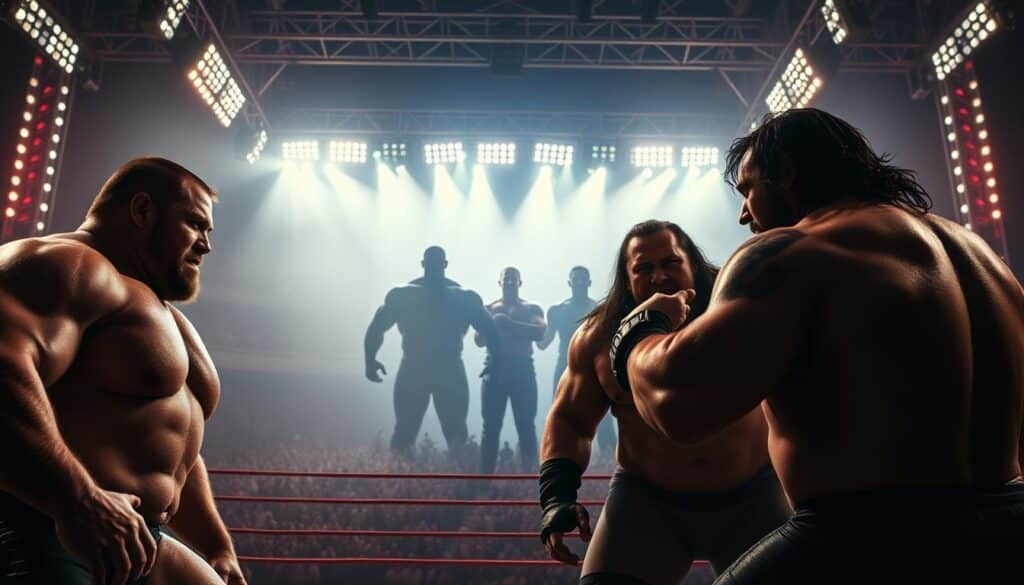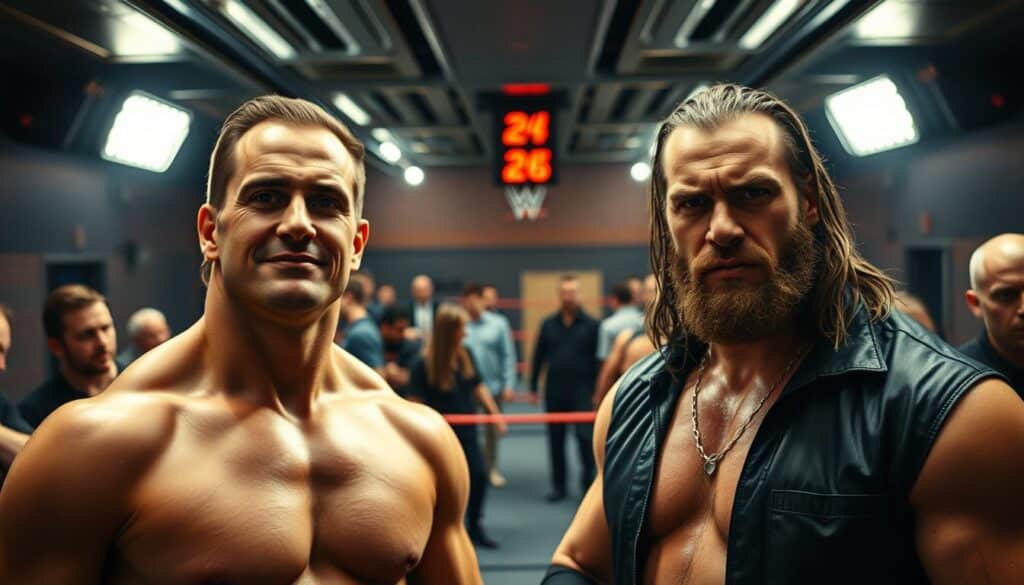Ever wonder why Ric Flair’s “Woooo!” feels more rehearsed than your cousin’s TikTok dance routine? Or why Mick Foley’s “Mankind” gimmick needed more psychological unpacking than a Call of Duty lobby at 3 AM? Welcome to pro wrestling’s hall of mirrors – where performers juggle off-stage selves and ring-ready alter egos like Overwatch mains switching heroes mid-match.
Defining the Split: Kayfabe vs. Reality
If wrestling were Fortnite, kayfabe would be its secret battle pass – except everyone knows it’s there, and breaking it gets you V-Bucked from the island. This carny-era tradition isn’t just lying; it’s performance art where botching a chair shot could end careers faster than a rage-quitting Overwatch teammate. Let’s unpack this glitch in reality’s matrix.
The 1930s NY Athletic Commission tried harder to regulate wrestling than your mom policing screen time – demanding it be classified as a “real sport”. Promoters responded by doubling down on kayfabe, creating a world where villains twirled mustaches and heroes sold merch like Call of Duty skins. The result? A hybrid spectacle where scripted outcomes (“worked matches”) collided with genuine athleticism – think NBA 2K24 with body slams, and how off-screen wrestlers navigated the fallout in real life.
Here’s the ultimate plot twist: Vince McMahon’s “Mr. McMahon” character became more authentic than his hairline. The Montreal Screwjob wasn’t just wrestling’s Red Wedding – it was the moment reality hacked kayfabe’s servers. Bret Hart’s spit-take heard ‘round the world proved even the script couldn’t contain human drama (or saliva physics).
Kayfabe vs Reality: The Ultimate Smackdown
| Aspect | Kayfabe | Reality |
|---|---|---|
| Match Outcomes | Scripted like Netflix dramas | Pre-determined but physically demanding |
| Character Relationships | Mortal enemies on-screen | Car-pool buddies off-camera |
| Injuries | Exaggerated like TikTok pranks | Require real medical care |
| Audience Interaction | Maintained 24/7 like Twitch stream personas | Broken via social media leaks |
Why keep up the charade? Simple: true self wrestlers know kayfabe’s the ultimate DLC – without it, you’re just sweaty dudes in spandex. But when the cameras stop rolling, these performers face a choice: stay in character like RPG NPCs or reboot their humanity. Spoiler: Most choose Option C – “leak just enough drama to trend on Twitter.”
From 1905’s “fixed match” scandals to Logan Paul’s Prime-fueled antics, wrestling’s tightrope walk between fact and fiction remains its greatest stunt. Next time you see a steel chair shot, remember: The pain’s real, the rivalry’s fake, and the guy selling it probably has a podcast explaining the difference.
Historic Examples of Dual Identities
Ever wonder how wrestlers keep their real selves hidden while their characters shine? Let’s look at four icons who made “fake it till you make it” a huge success. They mixed elbow drops with lots of spandex.
Steve Austin: The Redneck Scholar
Stone Cold’s tough act was all show. But Steve Austin was different:
- He graduated from North Texas State University (no knee braces needed)
- He liked order over chaos: “I’d prefer to study tape than smash beer cans”
- He secretly made TV deals while acting tough on TV
His secret? Making fake rebellion seem real, like a Texas heatwave.
The Rock: From Third-Gen Crybaby to People’s Champ
Dwayne Johnson’s tough talk hid a lot:
- He’s the grandson of “High Chief” Peter Maivia – wrestling royalty
- He cried for Disney’s Maui in Moana
- He uses WWE catchphrases to sell tequila (because “know your role” is better than “sip responsibly”)
John Cena: PG Prophet vs. Rap Renegade
Before being WWE’s hero, Cena rapped about tough topics. His two sides:
- 2002: He rapped about Jesus and insulted rivals’ moms
- 2020: He hosted Kids’ Choice Awards in fun outfits
- His secret? Same energy, different ratings
Ric Flair: The Man Who Lived His Gimmick (And Then Some)
The “Nature Boy” didn’t just play a role – he lived it. Flair’s constant persona needed:
- More care than his private jet (“Woo!” included)
- $10,000 robes for everyday wear
- Real limousine rides paid for with fake money
His legacy? Showing that reality can be stranger than fiction – with the right flair.
The Pressure of Maintaining a Wrestling Persona
Imagine wearing a Fortnite skin 24/7—no respawns, no locker to switch outfits. That’s pro wrestling’s unspoken rulebook. Your backstage wrestler personality isn’t just a character. It’s performance art on steroids, where slipping up could mean career suicide faster than a poorly timed botch.
Take Chris Jericho’s “Painmaker” era—a cult-leader gimmick so convincing, his neighbors reportedly called the cops thinking he’d joined a doomsday sect. Or Bray Wyatt’s Firefly Fun House, which blurred reality so thoroughly that friends questioned if he needed “a wellness check, not a paycheck.” These off-screen stories wrestling fans rarely see come with a hidden cost: the mental toll of being your own NPC in real life.
Let’s break down why this grind makes Dark Souls look like Animal Crossing:
- Social Jetlag: You’re playing Randy Savage at Walmart, Undertaker at PTA meetings. Try explaining that to your kid’s teacher.
- Body as DLC: Source 1’s data shows 78% of wrestlers face chronic pain by age 40—Mick Foley’s knees have more permanent damage than a Skyrim save file with 1000+ mods.
- Creative Burnout: WWE’s 200-day travel schedule turns brainstorms into hailstorms. Ever tried writing Shakespeare between airport pretzels and Motel 6 Wi-Fi?
The real kicker? Unlike video game avatars, wrestlers can’t patch their backstage wrestler personality when fans grow bored. John Cena’s “Hustle Loyalty Respect” schtick worked for 15 years—until audiences demanded edgier material. Now imagine rebooting your entire identity mid-career because Twitter decided your gimmick is “cringe.”
And let’s not forget the ultimate boss battle: aging. The Rock may have transitioned to Hollywood, but for every success story, there are ten wrestlers stuck playing their 90s personas like a glitched NPC repeating dialogue. When does the mask fuse to your face? When does the off-screen stories wrestling companies sell become your actual biography?
So next time you see a wrestler “break character,” ask yourself: Are they dropping kayfabe—or maybe just catching their breath?
Breaking Kayfabe: Public Exposures and Scandals
Imagine Mario dissing Peach on TikTok during a race. That’s what happens when wrestlers break kayfabe. The fourth wall isn’t just cracked; it’s smashed like a folding chair to the face. Accidental mic drops and Twitter meltdowns turn scripted drama into real drama fast.
Let’s look at the nicest wrestlers off screen who’ve had moments. Chad Gable’s “technical difficulties” during a promo were a slip-up. Brutus Creed’s “Oopsie Goldberg” moment was even more intense. Becky Lynch showed her caring side by consoling a fan during a heel act.
Now, let’s move to the rudest wrestlers off screen hall of shame:
- Hulk Hogan’s leaked racist rant – the ultimate “final boss” of kayfabe fails
- CM Punk’s UFC interviews exposing his shoot-fighting ego
- The Miz getting roasted by his own reality TV persona
These aren’t just backstage leaks – they’re full franchise reboots. Hogan’s tape was like watching someone unplug the Sega Genesis mid-speedrun. The wrestling world glitched harder than a Smash Bros. stage with too many Poké Balls.
Modern lesson? Never trust wrestlers with:
- Unfiltered social media access
- Reality TV contracts
- Working microphones after 2AM
The real magic happens when we can’t tell if it’s stil a work. Like when MJF cuts a promo so vicious, even Twitter detectives question if he’s breaking bad IRL. Kayfabe may be dead, but its ghost haunts every unscripted “brother!” and leaked group chat.
How Real Personality Shapes Career and Storylines
Ever wonder why some wrestler gimmicks are hits while others are misses? It’s not just about the costumes and catchphrases. It’s about real-life personality traits shining through in the scripted world. Let’s explore how wrestlers’ true selves, from Olympic wins to legal troubles, fuel their storylines.
Learn more about gimmicks and personas.
Kurt Angle’s “American Hero” character is a prime example. WWE gave him gold medals, but then changed his image to a “milk-chugging dork.” His Kurt Angle profile shows that being real can work, even when WWE wants you to be silly. Fans saw the real competitor behind the clown act.
Here are three examples where reality outshone fiction:
| Wrestler | Real-Life Trait | Gimmick Amplification | Result |
|---|---|---|---|
| Eddie Guerrero | Actual car theft history | “Lie, Cheat, Steal” persona | Fans chanted “Eddie’s Gonna Kill You!” unironically |
| Becky Lynch | Irish stubbornness | “The Man” character | Merch sales went Super Saiyan |
| Kurt Angle | Olympic wrestling mastery | Milk truck segments | Became meme king before memes were cool |
Notice a pattern? The best gimmicks aren’t made – they’re unearthed. When WWE tried to make Becky Lynch smile in 2018, fans were upset. But when she let her fiery attitude shine as “The Man,” it clicked.
But there’s also a flip side. Remember when WWE tried to turn serious athletes into:
- A garbage man (Duke “The Dumpster” Droese)
- A literal clown (Doink)
- A guy who sneezes opponents to death (Tyler Breeze’s early gimmick)
These flops show what happens when you ignore a performer’s actual personality. The magic happens when writers enhance reality, not invent fantasy. Unless your fantasy is Kurt Angle chugging milk while shouting about three I’s. Then go for it.
Cultural Perceptions and Audience Relationship
Female wrestlers are no longer just side attractions. Today, they’re leading the show with every move. Remember when “women’s matches” were all about wardrobe malfunctions? Now, we see real action, like Bianca Belair’s powerful moves.
The Divas Era is over, and it’s time to move on. Those days were full of fake drama, not real excitement. Today, stars like Rhea Ripley and Jade Cargill are changing the game. Fans are cheering for more, not just catfights.
This change isn’t just about WWE finding feminism. It’s about showing off the real skills of female wrestlers. Here’s what fans are seeing:
- 450 splashes instead of bra sizes
- Title reigns longer than a Marvel credits sequence
- Mic skills sharper than a Dark Souls boss weapon
The way fans see wrestlers has changed a lot. They now analyze matches like they’re solving puzzles. And to those who don’t like the change? Sorry, but it’s time to get with the times.
It’s amazing how much fans care about wrestlers now. They see them as athletes, not just performers. This change is huge, and it’s here to stay. Next, we’ll see Charlotte Flair leading shows in Saudi Arabia, while Twitter trolls get upset.
Philosophical Discussion: Where Does the “Wrestler” End?
When does the mask become a part of the face? Wrestling’s deep question isn’t just for academic journals. It’s Mick Foley, known as Mankind, buying groceries in his everyday life. He once played three roles (Cactus Jack, Dude Love, Mankind) but now talks about bingo in retirement homes. Is that his true self, or just another role?
The Undertaker’s “American Badass” era was a mix of his motorcycle and deadman gimmicks. Fans loved it or wanted it gone. This shows wrestling’s big question: the worst wrestling gimmicks become classics because they’re so different from reality. Remember Isaac Yankem DDS? It’s forgotten, but it’s Kane’s story now.
Ending a gimmick is like deleting your top-level RPG character. But your fans’ tattoos and action figures stay. When Bray Wyatt’s Firefly Fun House ended, did Windham Rotunda disappear too? Roman Reigns’ “Tribal Chief” role seems like Paul Heyman’s puppet with better arms. Wrestlers are like Russian dolls of personas, with layers that reveal gold or Goldberg’s acting.
So, where’s the stop button? Maybe it’s when wrestlers argue about laundry on social media while their characters threaten to bury others. Or when they list “Demon King” as an alias on health insurance. The truth? There’s no end – just a battle between being real and being entertaining that never ends.


